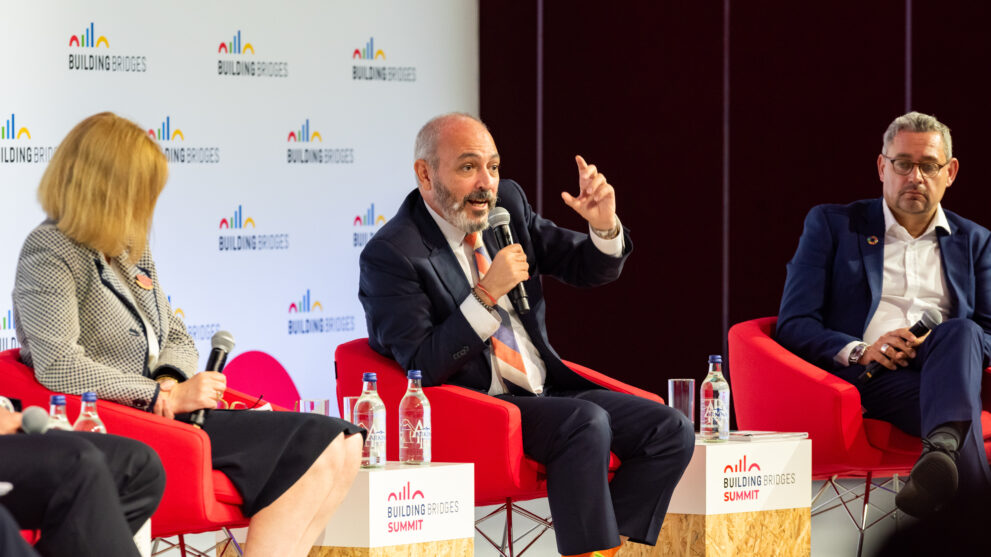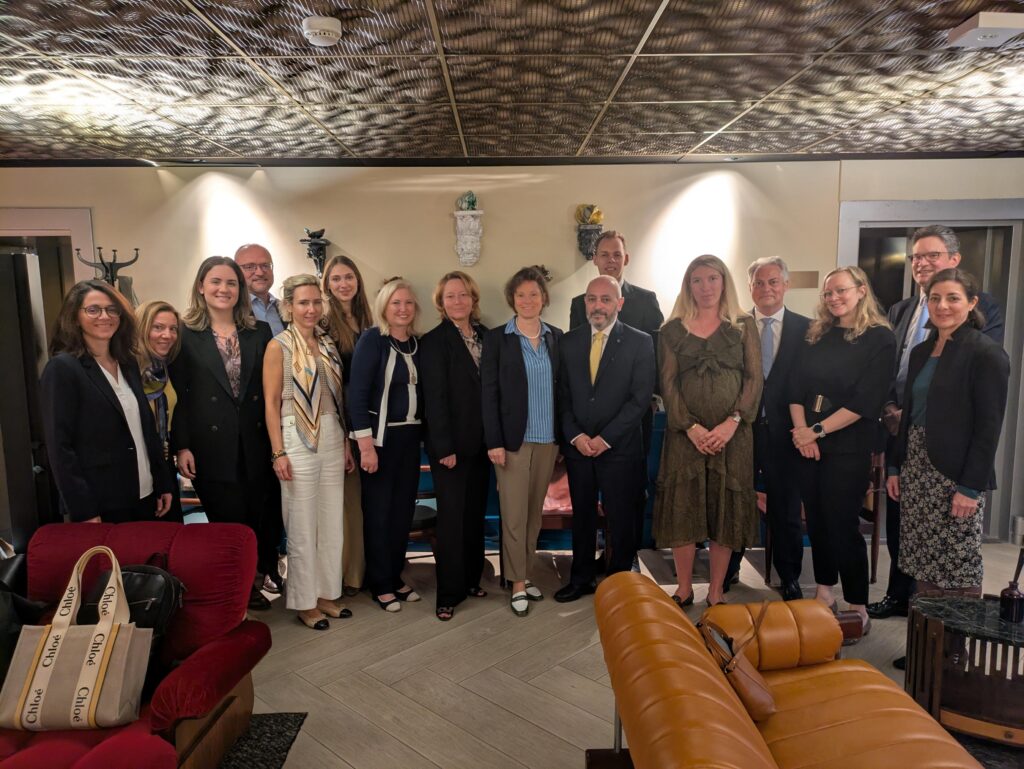It’s time for a recommitment to sustainability

Following a high-level breakfast discussion with financial leaders during his recent visit to Geneva, Building Bridges sat down with Marcos Neto, UN Assistant Secretary General and Director of UNDP’s Bureau for Policy and Programme Support, to explore the role of finance in advancing sustainable development from his perspective. Drawing on decades of experience, Neto shares how UNDP has helped shape enabling environments around the world, creating the stable conditions needed for profitable, impactful investment opportunities. With a priority around emerging markets and ensuring livelihoods for the worlds most vulnerable, he reflects on the past, present, and future of sustainable finance and the critical steps needed now, especially as we prepare for Building Bridges 2025 at the end of September. This year represents UNDP’s 60th anniversary, offering a timely opportunity to reflect on the organisation’s evolving role in the global financial ecosystem, especially in such volatile times.
UNDP is one of those institutions around us that many don’t understand fully – but they have been there for decades, quietly helping shape our world. How would you describe its core role today and your own focus within that?
It is great that Building Bridges is about helping make sense of the institutions and infrastructures involved in supporting progress. At UNDP, we play our part in a few different ways to facilitate and enable the flow of private capital into the sectors and regions where it’s most needed. With a presence in 170 countries and a 60-year track record, we’re consistently ranked among the top five most trusted institutions for government advice. That means we can influence policy and partner with public and private actors to enable investment.
Take insurance – agricultural insurance penetration remains incredibly low. Our role has always been to help close the gap, yet, in many countries, it’s shrinking, not growing. In places like California (following the fires) and Valencia (following the floods), climate risk is driving insurers to pull out. But, we know we what to do to make it work.
In Uzbekistan, where agriculture makes up 25% of GDP and fruit exports are big business, most farmers had no insurance. Climate change and unpredictable weather made the risk too high for insurers. There was no enabling environment. So we came in to work with the government, farmers, and global insurers like Swiss Re and Europe Re. We helped design a policy framework, define a price point, and introduced subsidies to make the product affordable. The result? Today, farmers in Uzbekistan have access to an insurance product co-financed by the government and backed by Reinsurance companies – companies now operating in this previously unchartered market. We’ve done this time and time again—creating environments where business can succeed, risk is shared, and the public interest is protected.
And we’re replicating this approach to creating enabling environments in Mexico, Argentina – sometimes it’s agriculture, sometimes climate infrastructure – but always public-private partnership.
UNDP is proud to be behind the scenes, enabling transformation on the ground. Here a just a few little-known moments that show how long we’ve been building bridges:
- Our assistance to the Brazilian government in the 1960s contributed to the creation of Embraer. UNDP laid the groundwork through partnerships to build the nations capacity in aviation and engineering.
- There is a city-state that also turns 60 this year – Singapore. Their first 10-year development was written with UNDP.
UNDP is strongly involved in shaping the sustainable finance landscape, including at Building Bridges’ events – what tools are proving most effective on the ground?
We’ve been with Building Bridges since day one and one of the tools we’ve brought to the community is the SDG Investor Maps. We’ve developed maps of over 60 countries, using private sector taxonomies and banking standards, helping to identify over 700 investment opportunity areas. Each map provides insights into policy environments, average ROI, ticket sizes – a market intelligence tool designed to shrink the due diligence process. Every opportunity is linked to the SDGs. This is a public good.
What we’ve also heard from investors at Building Bridges is this, “We’re busy. Tell us who we can make a deal with.” The tools are there, but they want plug-and-play partners. That’s why we’ve also built a platform out of our Rome office, focused on energy investment in Africa, supporting projects from feasibility all the way to investment-readiness. We also work on the public finance environment side – to help de-risk these opportunities.

Group photo from the Building Bridges Breakfast Discussion with Marcos Neto, 30 April 2025.
We often hear about the need to “create enabling environments”, but what does that really mean in practice? What are the ingredients that make partnerships work?
Like any good soup – it’s a mix of ingredients. Some intangible – like trust and relationships. Some very practical. If you work in insurance, you already know: climate change is a direct threat to your business. As risk rises – floods, fires – premiums increase. At some point, people will be priced out of coverage. So the industry is desperate for solutions. And the solutions the insurance sector needs are the same ones poor farmers or governments need. It’s a convergence of interests – and urgency.
It’s true for cocoa as well – we’re in Switzerland, think about the value chain. No cocoa = no chocolate. In Côte d’Ivoire – how do we increase yields without deforestation? The answer must work for farmers and for the planet. It’s not about making companies more profitable. I care about farmers livelihoods – but understanding different motivations is important to create shared solutions.
You’ve witnessed the evolution of sustainable finance firsthand. What shifts in collaboration do you think have been the most defining and where should we focus next?
Globally, 2021 stands out. When Italy had the G20 presidency and created the Sustainable Finance Working Group – co-chaired by the US and China. That work led to a roadmap that’s become a major reference point in the G20 and beyond.
And of course, for Building Bridges, we love the grassroots moments – like when we bring small businesses from developing countries to meet investors. Maybe it doesn’t change the world in a day – but if one connection works, the impact can ripple outward.
There was a time when the volume of finance for sustainable development was growing steadily. We were probably becoming too complacent, but now, we’ve hit a turning point. ESG has become politicised – on one end calling it “woke,” on the other, calling it a means for greenwashing. There’s confusion, fragmentation, and a lack of clear standards. We need to pause, reflect, and recommit – not throw the baby out with the bathwater.
This year’s Building Bridges should be a moment of renewal. Let’s move forward – but with more quality, more data, more clarity. Someone said at our breakfast: “We thought the market was 50% sustainable; maybe it’s only 20%.” You know what? That’s okay – as long as that 20% is truly committed to real impact and strong processes, and we can build up with better quality.
My final words:
- Recommit to sustainability as a core business strategy and look at biodiversity risk as a real opporunity.
- Not be distracted by short-term noise, focus on long-term triple impact: social, environmental and financial.
- Get off the fence, sustainability is political whether you like it or not. It is time for public, visible leadership and bold partnerships.
We Build Bridges Storytelling Series
Building Bridges is more than just an event—it’s a space for meaningful collaboration, fresh perspectives, and lasting connections. Through our storytelling series, we highlight the personal experiences that shape each edition. If you have a story to share about your journey at Building Bridges 2024—whether it’s a key insight, a memorable moment, or the impact of the bridges built—we’d love to hear from you!
Do you have a bridge-buidling story to share? Click here to submit one for review.
